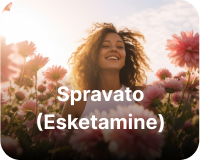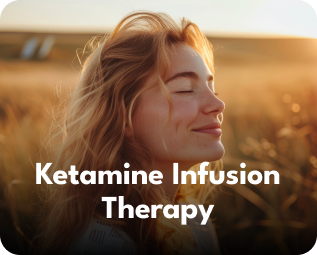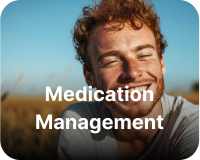Austin Mental Health Clinic
1600 W 38th Street, Suite 322, Austin, TX 78731
At Mindful Health Solutions, we’re passionate about making a difference in our communities, providing mental health care solutions that truly work for Austin locals struggling with mood and anxiety disorders, including treatment-resistant depression.
Located near Seton Medical Center and the Heart Hospital of Austin, our Austin mental health clinic offers in-clinic and telehealth services throughout the state of Texas, with services including medication management and telehealth in Texas, as well as Transcranial Magnetic Stimulation (TMS) and SPRAVATO (esketamine) nasal spray, both FDA approved for the treatment of depression.
We are especially proud to be one of the few mental health clinics offering Ketamine Infusion Therapy in Austin – a revolutionary approach to rapid depression relief.
Call our Austin ketamine clinic and TMS specialists at 737-207-9686 to schedule an appointment today!
Clinicians on Staff

Victoria Nettles, MD
Psychiatrist

Megha Chadha, MD
Psychiatrist

Matt Stephens, DO
Psychiatrist
At Mindful Health Solutions, our dedicated and skilled psychiatrists work tirelessly to ensure that each patient who walks through the doors of our Austin mental health clinic is treated with respect and compassion. We understand how difficult it can be to navigate the struggles of everyday life when you are suffering from mental health conditions like clinical depression, anxiety, OCD, and bipolar disorder, and our goal is to help you mitigate those difficulties so you can live your best life.
Our Austin psychiatrists and other members of your care team will consult with you and provide you with an individualized plan, often including an assessment and medication management service, as well as interventional psychiatric treatments such as Spravato (Esketamine), Ketamine Infusion Therapy, and Transcranial Magnetic Stimulation (TMS) therapy in Austin.
If you’re unable to come into our Austin ketamine clinic, we offer telepsychiatry, allowing you to get quality care from the comfort of your home.
Parking:
The building for our mental health clinic in Austin has a parking lot.
Located near Seton Medical Center and the Heart Hospital of Austin
Mindful Health Solutions
Contact Mindful Health Solutions to Determine If SPRAVATO, Ketamine Therapy, or TMS Therapy in Austin Is Right for You
Please fill out the form and you will be contacted by a member of our team to discuss TMS, SPRAVATO, and/or ketamine therapy in Austin.
You may also call (737) 207-9686 to speak with an Intake Specialist about scheduling an appointment with our psychiatrists in Austin. During the call, we will review insurance coverage and potential costs, discuss your mental health struggles, and go over treatment options for you or your loved one.
Insurance
We are in-network with Kaiser, Medicare, and all major commercial insurance plans.
Covered by Most Insurance Carriers
Frequently Asked Questions - TMS Clinic in Austin
What is TMS?
What Is TMS Therapy in Austin?
TMS (Transcranial Magnetic Stimulation) is a non-invasive, FDA-approved treatment for depression and other mental health conditions. It uses magnetic pulses to stimulate the brain’s prefrontal cortex, which regulates mood. Unlike medications, TMS does not travel through the bloodstream and has fewer side effects. It is a well-tolerated option for those who haven’t responded to antidepressants or prefer a drug-free treatment.
TMS is primarily used for treatment-resistant depression, but research shows it can also help with symptoms of anxiety, OCD, PTSD, migraines, and more.
How does TMS work?
TMS stimulates the prefrontal cortex, which is responsible for mood regulation. Magnetic pulses activate neurons, helping to restore neurotransmitter balance (such as serotonin and dopamine). This can relieve depression symptoms long-term, unlike antidepressants, which only work while in the bloodstream.
What happens in a session?
- You’ll sit in a comfortable chair while a TMS coil is placed on your head.
- The device sends painless magnetic pulses to stimulate brain activity.
- You can watch TV, listen to music, or talk during treatment.
- Sessions last 20–30 minutes, 5 days a week for 4–6 weeks.
- No sedation or downtime—patients can drive home and resume normal activities.
Is TMS safe, and are there any side effects of TMS?
What are the success rates of TMS?
Transcranial Magnetic Stimulation (TMS) has been shown to be more effective than antidepressants for many patients:
- 50% of patients experience a significant reduction in symptoms.
- 30–33% achieve full remission, meaning symptoms completely disappear.
- Many patients start feeling better after 2–3 weeks, with full results after 6 weeks.
Unlike antidepressants, which must be taken continuously, TMS treatments provide long-lasting relief without the side effects of medication.
Will TMS therapy affect my current medications?
TMS treatments do not directly impact medications, but as symptoms improve, some patients may reduce or discontinue antidepressants under medical supervision.
- If you're already on medication, your provider will decide whether to continue or adjust it.
- If you're not taking medication, TMS can be a standalone treatment or part of a combined approach.
- Each treatment plan is personalized to fit your needs.
Your provider will monitor your progress and adjust your treatment plan as needed.
How is TMS different from ECT?
ECT vs TMS - it's important to know that these are not the same! While both TMS and ECT are brain stimulation treatments for depression, they work very differently:
- ECT uses an electrical current to induce a controlled seizure, requiring general anesthesia in a hospital. It’s typically used for severe, life-threatening depression and can cause memory loss.
- TMS uses magnetic fields to stimulate a specific brain area without inducing seizures or requiring anesthesia. It has minimal side effects, and patients can resume daily activities immediately.
Discover a new era of TMS with Mindful Health Solutions. TMS is a non-invasive outpatient option with fewer risks, making it a preferred choice for many individuals.
How can I tell if I’m depressed?
Depression can be debilitating, and early diagnosis is important. Ask yourself:
- Has my sleep, appetite, or energy changed?
- Am I avoiding social interactions or losing interest in hobbies?
- Do I feel agitated, tearful, or hopeless most days?
- Have I engaged in risky behaviors or self-harm?
If these resonate with you, consider taking a Depression Screening and seeking professional help. Early treatment increases the chances of remission and long-term well-being.
Is TMS covered by insurance?
Yes! Most major insurances cover TMS, and we’ll work directly with your insurance provider on your behalf to help you get covered.
Frequently Asked Questions - Austin SPRAVATO Clinic
What is esketamine therapy, and how does it work?
What is SPRAVATO, or esketamine, nasal spray?
Esketamine is an FDA-approved nasal spray (Spravato) used for treatment-resistant depression (TRD). Unlike traditional antidepressants, which target serotonin, esketamine works by increasing glutamate, improving brain cell communication and mood regulation.
Why esketamine therapy at our Austin esketamine clinic?
- Works faster than antidepressants (effects may begin in hours or days)
- Helps patients who haven’t responded to other medications
- Administered in a clinical setting under medical supervision
Who is esketamine nasal spray for?
Esketamine is recommended for adults with treatment-resistant depression who have:
- Tried at least two antidepressants without success
- Experienced less than a 50% improvement in symptoms
It is also approved for individuals at risk of suicide.
What does an esketamine treatment session look like?
Esketamine is administered as a nasal spray in a certified clinic.
During a session:
- You self-administer the spray under medical supervision
- You remain at the clinic for two hours for monitoring
- Most patients receive 12 treatments over two months
Because of possible short-term side effects, you’ll need someone to drive you home after each session.
Is esketamine safe, and are there any side effects of SPRAVATO?
Esketamine is safe when used as directed, but like any medication, it has potential side effects.
Common, short-term SPRAVATO side effects:
- Sleepiness or dizziness
- Nausea
- Increased blood pressure
- Temporary dissociation (feeling detached)
These effects usually fade within 1–2 hours. Esketamine carries a low risk of dependence, but regular monitoring by a doctor is required.
How effective is esketamine treatment?
Studies show that esketamine therapy, when combined with an antidepressant:
- Helps 70% of patients experience at least a 50% symptom reduction
- Leads to full remission in 50% of patients
Some patients feel better after just one SPRAVATO therapy session, but most see full results after 12 treatments over two months.
Does insurance cover esketamine nasal spray?
Insurance coverage for esketamine is expanding, but approval varies. Our team will work directly with your provider to help secure coverage. We also offer out-of-pocket payment options for those without coverage for esketamine therapy.
Frequently Asked Questions - Ketamine Infusion Therapy in Austin
How do you feel during IV ketamine for depression treatment?
Wondering, how does ketamine therapy work? Ketamine infusion treatments are often described as an “out-of-body experience.” Patients may experience dissociation during ketamine infusion therapy for treatment-resistant depression, often reported as a pleasant feeling that relieves symptoms of depression. Dissociation can include:
- Feeling detached from your body
- Having a distorted perception of time and space
- Experiencing altered perceptions and sensations
- Entering a dream-like state where thoughts may become distorted
- Emotional detachment
Some individuals describe a sense of mental clarity or expanded consciousness during IV ketamine for depression, especially treatment-resistant depression.
How effective is IV ketamine therapy?
Wondering, how does ketamine therapy work?
Clinical studies show that ketamine infusion therapy for treatment-resistant depression and Major Depressive Disorder has a success rate as high as 70%. Many patients show rapid improvement after just their first or second IV ketamine treatment infusion.
How are ketamine infusions administered?
You may be asking yourself, how does ketamine work?
Ketamine Infusion Therapy treatments are administered at our certified ketamine clinic in Austin. The session will begin by getting you situated in a comfortable chair and your clinician will get you settled with the IV. Your clinician will inform you when the IV has started. The infusion lasts 40 minutes and the entire session takes about 90 minutes to complete.
What does a ketamine therapy session look like?
IV ketamine therapy is an office-based, outpatient procedure. The ketamine infusion lasts 40 minutes and the entire session takes about 90 minutes to complete. The session process will begin by getting you situated in a comfortable chair. Then, your clinician will inform you when the IV has started.
The first thing you will feel is a sense of relaxation of mind and/or body. You may then begin to feel slightly light or light-headed. Some people report a sense of feeling a slight warmth. Eventually, you may feel even lighter, almost a slight separation between yourself and your body. Your hands and legs may feel far away. Some people progressively feel more separation between themselves and the different components of consciousness (e.g., their thoughts, feelings, bodily sensations, and perception). Occasionally, people continue to progressively experience an even greater physical sensation of lightness – sometimes to the point of feeling above the room. Patients generally tolerate these sensations very well, reporting the experience as “spiritual” or “pleasurable.”
If someone is struggling with depression, anxiety, or rumination, this point is when they feel much less of and/or distant from these feelings. This experience is frequently described as an immense relief – like the blanket of depression has been temporarily lifted. This experience can also serve as a very hopeful reminder to patients that depression or anxiety does not define them. These conditions are separate from them, and as such, they can be temporary.
In rare cases, patients may have a more negative experience after receiving a ketamine intravenous injection. We have psychiatric professionals on-site to help manage these rare events, which are generally brief and usually resolve completely within 10-15 minutes after stopping the infusion.
Reach out today to learn more about the process during ketamine infusion treatments.
Are there any side effects of ketamine infusion therapy?
The most common side effects of ketamine usually only occur up to two hours after the ketamine infusion has been administered. To help ensure the safety of patients, there is a two-hour window of supervision at the clinic following the administration before patients can leave and head home. Although you may not experience any of these IV ketamine side effects, the most common include:
- Double vision
- Loss of appetite
- Dream-like state
- Nausea
- Elevated blood pressure
- Trouble speaking
- Slight pain at the injection site
- Dissociation or feeling strange/loopy
How many sessions should I expect?
Initial ketamine infusion therapy for treatment-resistant depression consists of 6 IV ketamine treatments over the course of 3 weeks. The details of this protocol are discussed in detail during the initial evaluation. Infusion appointments generally take 90–120 minutes. If the symptoms are successfully controlled with these initial treatments, then follow-up evaluations will be conducted to determine long-term treatment plans.
Maintenance treatments for IV ketamine for depression usually consist of one infusion every 2-4 weeks.
How much does ketamine therapy cost?
Ketamine Infusion Therapy (KIT) for major depression or other psychiatric indications is $600 per treatment. With the exception of Kaiser insurance and some TriCare/TriWest plans, KIT is not eligible for insurance at this time. However, KIT may be eligible for some reimbursement with a Flexible Spending Account (FSA) or Health Savings Account (HSA). Coverage will vary depending on the specific FSA or HSA plan and your health insurance carrier. Therefore, we recommend that you contact your insurance plan before treatment.
Note that the number of IV ketamine for depression treatments may vary per patient, with most patients completing between 6-12 IV ketamine treatments.






